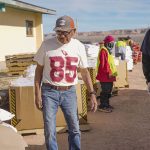
Priorities for Nez’s ARPA plan revealed
WINDOW ROCK
In a closed-door leadership meeting last Friday at Twin Arrows Casino, the president’s office and executive branch staff presented the Navajo Nation Council and Chief Justice JoAnn Jayne with their proposed allocation of the of the Navajo Nation’s $2.1 billion in ARPA funds.
The list includes:
- $200 million for broadband internet connections
- $200 million for water lines and wastewater projects
- $160 million for power lines
- $140 million for bathroom additions
- $80 million for housing
- $220 for chapter community projects
- $80 million for educational initiatives
- $80 million for wellness centers, detox centers, senior centers and transitional housing
- $80 million for social services
- $90 million for economic development
- $20 million for tourism industry
- $100 million for tribal enterprises
- $207 million for hardship assistance, previously approved by Council
- $246 million in reimbursed Sihasin, UUFB and defunded CARES Act projects
- $165 for ARPA administration and regulatory support
The only thing missing from the presentation were detailed project lists for each category as part of the plan, including for chapters.
“We did not receive any listing,” said Delegate Vince James. “I tried to receive a breakdown of all the projects that were reviewed by DOJ and given the thumbs up, but we haven’t received anything.”
James said he thought the whole point of the meeting was to share ARPA approved project lists from each delegate’s chapters, but that was not the case.
“We were told they would get us the information, but they didn’t give us a timeline or a date when we would receive it,” said James.
He confirmed that many delegates are confused about what happens next.
“I went to Jeddito Chapter meeting yesterday and they’re asking me what’s being funded and I said I’m sorry, we didn’t get a listing again,” said James. “We still don’t know which projects are going to be funded. I had to apologize.”
During the Friday meeting, Division of Community Development Director Pearl Yellowman did say there are 558 project applications from chapters, which totaled $1.1 billion, but did not respond to a request from the Navajo Times for a list of what chapter projects were approved.
She did indicate requests included bathroom additions, house wiring, rural addressing, warehouses, assessments, building renovations, cemeteries, chapter buildings, community centers, trash clean-up, kitchens, housing and equipment.
Needs outweigh ARPA funds
The Council established the Fiscal Recovery Fund and the expenditure authorization process for ARPA funds, including a procurement process with oversight guidelines, which President Jonathan Nez signed into law in August.
The president’s office has emphasized that the project list compiled by the executive branch for the Navajo Nation totals $18.7 billion and contains about 10,000 projects, which far exceeds the $2.1 billion available in ARPA funds.
The challenge has been to pare down the needs to what is achievable within the ARPA framework.
“Clearly, $2 billion will not meet all of the needs in our communities, but it is a start and it is an opportunity to improve the quality of life for future generations through infrastructure development and other initiatives included in the proposal,” President Jonathan Nez stated in an Oct. 15 press release after the leadership meeting.
On Oct. 14, Nez signed off on reimbursements of eligible defunded CARES Act allocations and appropriations that were previously funded through the Nation’s Síhasin Fund and Unreserved, Undesignated Fund Balance. That breakdown, vetted by the Department of Justice, includes:
- $185 million to connect homes to electricity water/wastewater and septic systems and provide broadband to residents and businesses.
- $12 million for the Navajo Department of Health for COVID-19 testing, emergency food assistance, medical transport, mobile medical units, and Personal Protective Equipment.
- $31 million for the Division of Economic Development to provide artisan and business economic COVID-19 relief grants to those who did not previously receive funding.
- $6 million for the Judicial Branch programs and Navajo courts to address the backlog of court cases, hire court personnel, provide outreach and transportation for clients, and for PPE and COVID-19 safety improvements.
- $8 million for heavy equipment for chapters including backhoes, vehicles, trailers, and tractors.
- $2 million for burial assistance for families that lost a family member due to COVID- 19.
“We are working together to carefully allocate ARPA money for our small businesses, chapter projects, the tourism industry, and our infrastructure initiatives,” said Speaker Seth Damon. “The Navajo people need jobs and immediate assistance.”
Nez said that while Council’s resolution states that hardship payments will be available in 2024, he supports amending that language to issue hardship assistance to enrolled members as soon as possible.
He recommended that equal hardship payments be given to all enrolled members of the Navajo Nation, meaning the same amount would go to adults and children.
With $207 million allocated to about 400,000 enrolled members, payments would amount to about $500 per person.
“This is really great news,” Delegate Eugenia Charles-Newton, who has been advocating for another round of assistance, said in a Facebook post on Saturday. “I’m just really excited and I’m really happy to hear that he does support it. I don’t think it’s going to be an uphill battle anymore.”
Charles-Newton had wanted to distribute larger payments to the people but increasing the amount of ARPA funding available for hardship would require the Council to amend its resolution through new legislation to remove the 10% cap on hardship assistance.
‘An enormous task’
On Oct. 4, Nez established the Navajo Nation Fiscal Recovery Fund Office by executive order that the president’s office currently is in the process of staffing.
The FRF Office, which will initially be housed at the Navajo Department of Transportation, will be in charge of educating the public on ARPA related activities, collaborating with Navajo Nation departments and offices, approving and overseeing projects, and ensuring compliance with provisions of ARPA and Navajo Nation laws.
At the Twin Arrows meeting, executive branch officials also provided updates about ongoing work to expedite the right-of-way approval process, personnel recruitment, and the procurement process to speed up the development and completion of infrastructure projects and other initiatives.
“We will continue to work together with the Council to finalize plans and fully implement the ARPA funds,” said Nez. “We appreciate the work of the Council, divisions and programs, chapters, and many others who are taking on this challenging task.”
Nez said next steps will include working with the Council to draft legislation to begin approving expenditure plans to allocate funding for new projects and to expedite hardship assistance.
He estimated the massive ARPA legislation will contain around 110 expenditure plans so this could be a long and arduous process.
“It’s an enormous task to implement this level of funding,” said Vice President Myron Lizer. “We have to take the time to plan carefully and ensure that we are complying with the U.S. Treasury’s guidelines and requirements and our own internal processes.”
Delegate Wilson Stewart Jr. said in order to work together effectively, the lines of communication between all branches of the Navajo government have to be open and transparent.
“Our people are ready to get to work in their communities,” said Stewart. “They can design, construct and oversee our ARPA projects. We will get through this pandemic and the ARPA funds are a major investment into the future of the Navajo Nation.”
As a public service, the Navajo Times is making all coverage of the coronavirus pandemic fully available on its website. Please support the Times by subscribing.
How to protect yourself and others.
Why masks work. Which masks are best.
Resources for coronavirus assistance








 Highway 264,
Highway 264, I-40, WB @ Winslow
I-40, WB @ Winslow